5. Operation
5.1. Inverter
The inverter can be turned on via these methods:
Front push button.
Main power switch at bottom of unit (5kVA model only).
The VictronConnect app.
Remote terminal with wire loop.
Remote switch connected to the remote terminal (optional).
Inverter Control VE.Direct panel connected to the remote terminal (optional).
A GX device and the VRM portal (optional).
5.1.1. On/Off Push button
When switched to “ON” with the push button, the product is fully functional. The inverter will come into operation and the LED “inverter” will light up. By pushing the push button subsequently, within a short period of time, the inverter toggles between “ON”, “ECO” and “OFF”. The inverter goes into sleep mode with minimal current consumption when the unit is turned off by the push button.
Note that when the inverter is switched off via Bluetooth or the push button, it cannot be switched on and off again via the wired VE.Direct port.
5.1.2. On/off Switch (5kVA only)
In addition to the front push button, the 5kVA model also has a main on/off switch. This switch, when turned off, will cut off the supply current completely.
The switch is located at the bottom right of the inverter, next to the battery cable entries.
5.1.3. ECO Mode
The inverter can be switched to ECO mode, via the VictronConnect app or the front push button.
When the inverter is running in ECO mode it reduces power consumption in no-load (standby) operation. The inverter will automatically switch off as soon as it detects that there is no load connected. It then switches on, briefly, every 3 seconds to detect a load. If the output power exceeds the set level, the inverter will continue to operate.
For more information about ECO mode, see the ECO mode and ECO settings chapter.
5.2. LED definitions and troubleshooting
LED panel | LED behaviour | Operational mode | Troubleshooting |
|---|---|---|---|
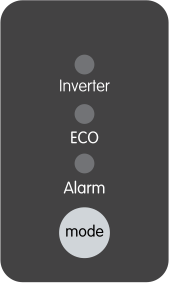 | All LEDs are off. | The inverter has been switched off, either directly or via its remote on/off connector, or the inverter is not powered. | To check if inverter is operational, push the "mode" button once. If not operational, check the following:
|
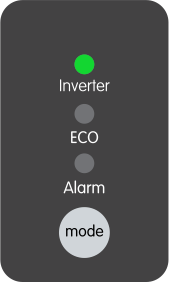 | The green inverter LED is on. | The inverter has been switched on and is operational. | n/a |
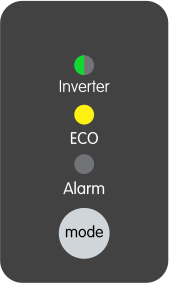 | The green inverter LED is blinking. The yellow ECO LED is on. | The inverter has been switched to ECO mode and is in "search" state. In other words, the inverter load is lower than the "Wake up power" setting. the inverter sends a search pulse at regular intervals to check if a load has been connected or has been turned on. | If the inverter keeps switching on and off while there is a load connected, the load may be too small compared to the actual ECO mode settings. Either increase the load or change the "wake up power" setting. |
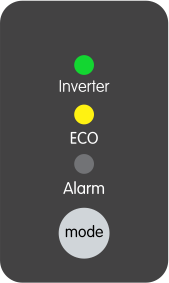 | The green inverter LED is on. The yellow ECO LED is on. | The inverter has been switched to ECO mode and is in "inverting" state. In other words, the inverter load is higher than the "Shut down power" setting and is powering the load. | n/a |
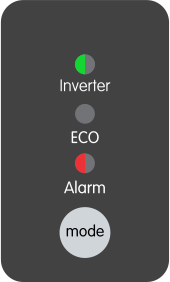 | The green inverter LED is blinking. The red Alarm LED is blinking. | The inverter is off and a firmware update is in progress or a firmware update has failed. | If the firmware update failed, retry the firmware update. |
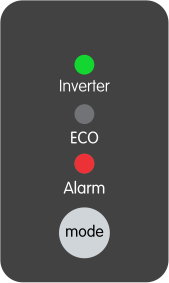 | The green inverter LED is on. The red Alarm LED is on. | Overload warning. The inverter is indicating that the AC load is larger than the inverter rating and that if this situation continues, the inverter will switch off due to an overload alarm | Reduce the AC load |
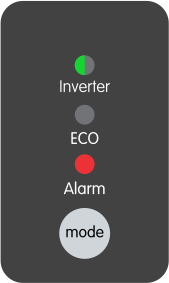 | The green inverter LED is blinking with a fast double pulse. The red Alarm LED is on. | Overload alarm. The inverter has shut down due to prolonged overload and will no longer automatically restart. | Remove the cause of the overload and then restart the inverter by switching it off and then back on again. |
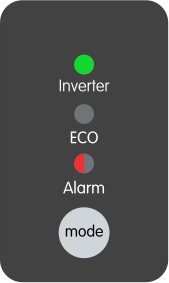 | The green inverter LED is on. The red Alarm LED is slowly blinking. | Low battery voltage warning. The battery voltage has dropped below the "Low battery alarm" voltage. Should the battery voltage drop any further, the inverter will switch off on a "Low battery voltage alarm". | Charge the battery and/or turn AC loads off. Also check if all battery cable connections have been tightened. Do the battery cables have a sufficient thickness, is the battery full and is the battery still in good working order? |
The green Inverter LED is on. The red Alarm LED is fast blinking. | High Battery voltage warning. The battery voltage is too high. Should the battery voltage increase any further, the inverter will switch off on a "High battery voltage alarm". | Reduce the DC input voltage, check if the battery voltage is correct and if the battery bank is wired correctly. Also check if there perhaps are faulty or incorrect chargers or equipment with a faulty charge regulator. | |
The green Inverter LED is on. The red Alarm LED is blinking with a double pulse. | High temperature warning. The internal temperature is too high. If the temperature increases any further, the inverter will switch off on a "High temperature alarm". | Reduce the AC load and/or move the inverter to a better ventilated area. | |
The green Inverter LED is on. The Alarm LED is blinking with a fast single pulse. | High DC ripple warning. The DC voltage has a too high ripple voltage. If the ripple voltage increases any further, the inverter will switch off on a "High DC ripple alarm". | Check if all battery cable connections have been tightened. Do the battery cables have a sufficient thickness? DC ripple is related to a voltage drop over the battery cables. For more information on DC ripple and how to prevent it, see the Wiring Unlimited book. | |
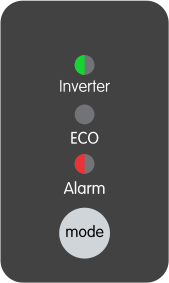 | The green inverter LED is blinking with a fast double pulse. The red Alarm LED is slowly blinking. | Low battery voltage alarm. The inverter has shut down due to low battery voltage. | To restart the inverter, charge the battery or switch the inverter off and then back on again. Check the battery voltage at the battery terminals of the inverter. Also check the DC fuses, cables, and cable connections For more information also see the Protections and automatic restarts chapter. |
The green inverter LED is blinking with a fast double pulse. The red Alarm LED is fast blinking. | High battery voltage alarm. The inverter has shut down due to high battery voltage. | Reduce the DC input voltage, check if the battery voltage is correct and if the battery bank is wired correctly. Also check if there perhaps are faulty or incorrect chargers or equipment with a faulty charge regulator. The inverter will automatically turn back on when the battery voltage has dropped to an acceptable level. For more information also see the Protections and automatic restarts chapter. | |
The green inverter LED is blinking with a fast double pulse. The red Alarm LED is blinking with a double pulse. | High temperature alarm. The inverter has shut down due to high temperature. | Wait until the inverter has cooled down. The inverter will automatically turn back on when its internal temperature has dropped to an acceptable level. Check the environment of the inverter, can the ventilation be improved, or can the inverter be moved to a cooler location? For more information also see the Protections and automatic restarts chapter. | |
The green inverter LED is blinking with a fast double pulse. The Alarm LED is blinking with a fast single pulse. | DC ripple alarm. The inverter has shut down due to high DC ripple. | Check if all battery cable connections have been tightened. Do the battery cables have a sufficient thickness? DC ripple is related to a voltage drop over the battery cables. For more information on DC ripple and how to prevent it, see the Wiring Unlimited book. To restart the inverter switch the inverter off and then back on again. For more information also see the Protections and automatic restarts chapter. |
5.3. Protections and automatic restarts
Overload
Some loads like motors or pumps draw large inrush currents in a start-up situation. In such circumstances, it is possible that the start-up current exceeds the over current trip level of the inverter. In this case the AC output voltage will quickly decrease to limit the output current of the inverter. If the over current trip level is continuously exceeded, the inverter will shut down, wait 30 seconds and then restart.
After 3 restarts, followed by another overload within 30 seconds of restarting, the inverter will shutdown and remain off. The LEDs will signal shutdown due to overload. To restart the inverter, switch it off and than back on again.
Low battery voltage (adjustable)
The inverter will shut down when the DC input voltage drops below the "Low battery shutdown" parameter. The LEDs will signal shutdown due to low battery. The inverter will automatically restart, after a minimum delay of 30 seconds, when the battery voltage has increased above the "Low battery restart" parameter.
After three restarts, followed by another low battery shutdown within 30 seconds of restarting, the inverter will shutdown and remain off. The LEDs will signal shutdown due to low battery. To restart the inverter, switch it off, and then on again. Alternatively, recharge the battery. The inverter will automatically restart when the battery voltage has increased for at least 30 seconds above the "Charge detect" parameter.
See the Technical specifications chapter for default low battery shutdown and restart levels. The levels can be customized via the VictronConnect app.
Alternatively, a dynamic low battery cut off can be implemented. For more information, see the Dynamic cut off chapter.
High battery voltage
The inverter will shut down when the DC input voltage is too high. The LEDs will signal shutdown due to high battery. The inverter will first wait 30 seconds and will only resume operation once the battery voltage has dropped to an acceptable level.
Check for faulty battery chargers, alternators or solar chargers connected to the battery.
High temperature
The inverter will shut down if it detects a too high internal temperature. The LEDs will signal shutdown due to high temperature. The inverter will wait 30 seconds and will only resume operation when the temperature has dropped to an acceptable level.
High temperature alarms are generally caused by a too high ambient temperature, often in combination with a high inverter load. Check if the area the inverter is used in, is well ventilated and perhaps even air-conditioned.
High DC ripple
The inverter will shut down if it detects a too high DC ripple. The LEDs will signal shutdown due to high DC ripple. The inverter will wait 30 seconds and then resumes operation again. If after 3 restarts, the DC ripple voltage is still too high, the inverter will shutdown and will not attempt to restart again. To restart the inverter, switch it off and then switch it on again.
High DC ripple is usually caused by loose DC cable connections and/or too thin DC wiring. To clear or prevent ripple alarms, check the wiring between the battery and the inverter. Check if the wiring is the recommended thickness, that all connections are tightened correctly and that the fuses and battery isolators are in good working order. For more information on DC ripple see the Wiring Unlimited book.
Continuous high DC ripple reduces the life expectancy of the inverter.
5.4. Monitoring via VictronConnect
The VictronConnect app can be used to monitor the inverter.
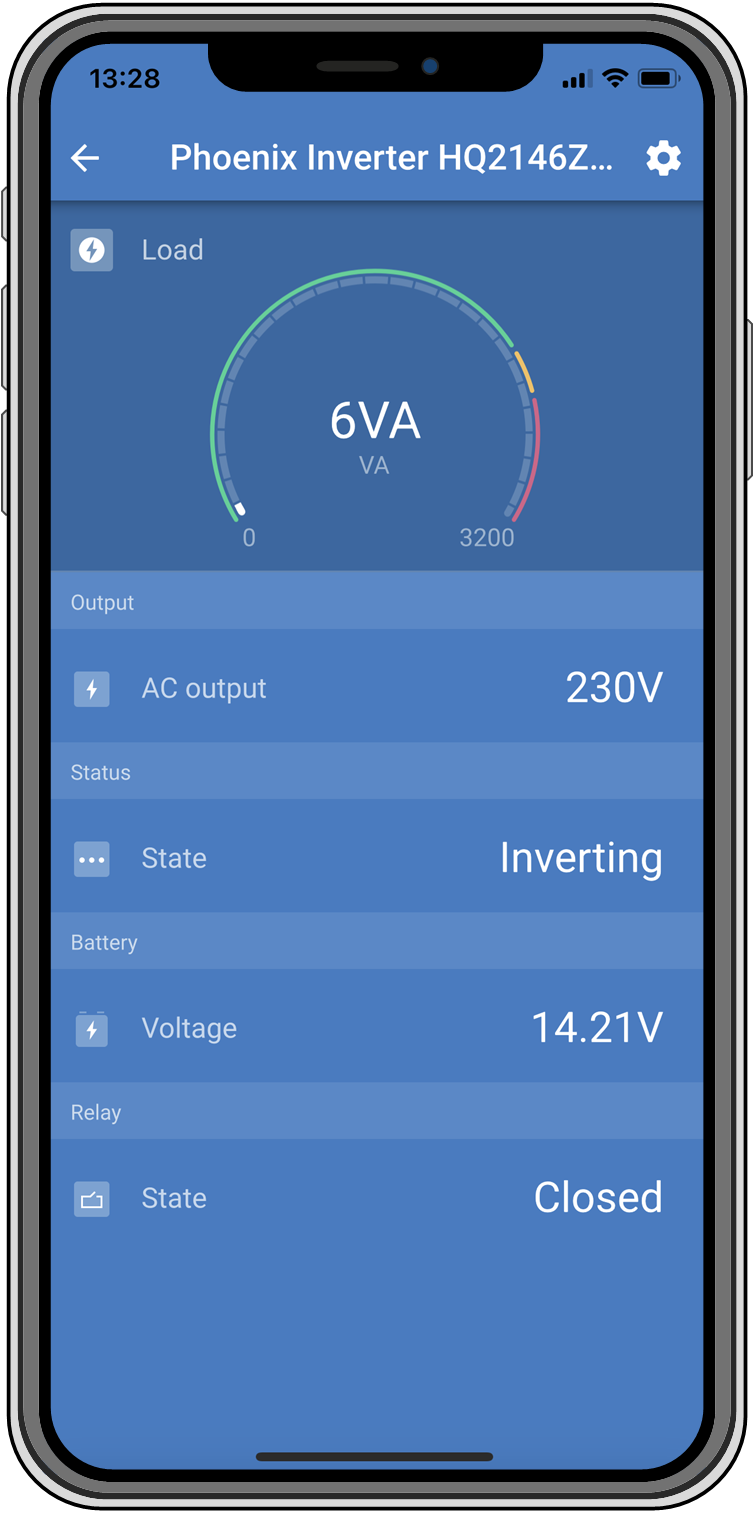 |
VictronConnect app.
For information on how to connect see the The VictronConnect app chapter and/or the VictronConnect manual which can be found on the VictronConnect app information page.
The VictronConnect app will display the following information:
Inverter load in VA.
AC output voltage.
Battery voltage.
Operational state.
Programmable relay state.
Warning or alarm messages *.
*) Please note that the app is not active in the background. This means that the app will not send alarms or warnings to your phone unless the app is active in the foreground.
5.5. Monitoring via a GX device, GlobalLink and the VRM portal
The inverter can be connected to a GX device, like a Cerbo GX or a Color Control GX. When connected the GX device will display the inverter on the system overview screen and the device list. The GX device will also display a message in case of an inverter warning or alarm.

Example of GX screens from left to right: system screen, inverter device screen and an alarm message.
If the GX device is connected to the internet, the inverter can be remotely monitored via the VRM portal. For more information on the VRM portal, see the VRM - Remote monitoring information page.
Alternatively, the inverter can be connected to a GlobalLink 520, and then remotely monitored via the VRM portal.